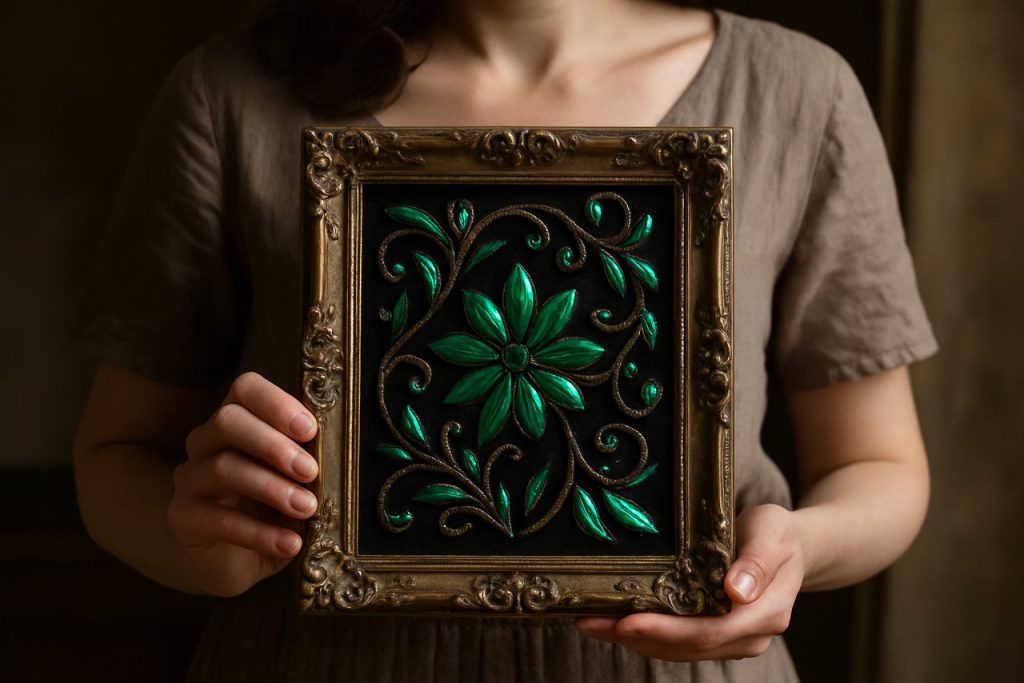
Beetlewing Art: The Mesmerizing Fusion of Nature and Human Creativity. Discover How Iridescent Beetle Wings Have Shaped Decorative Traditions, Inspired Modern Design, and Captivated Audiences Worldwide. (2025)
- Origins and Cultural Significance of Beetlewing Art
- Traditional Techniques: Harvesting and Preparing Beetle Wings
- Iconic Examples: Historic and Contemporary Masterpieces
- Materials Science: The Iridescence Behind the Beauty
- Beetlewing Art in Fashion and Textile Design
- Conservation, Ethics, and Sustainable Sourcing
- Museum Collections and Notable Exhibitions
- Modern Innovations: Technology and New Applications
- Market Trends and Public Interest Forecast (2024–2030)
- Future Outlook: Preserving and Evolving Beetlewing Art
- Sources & References
Origins and Cultural Significance of Beetlewing Art
Beetlewing art, a unique decorative tradition, traces its origins to the use of iridescent beetle elytra (wing cases) as embellishments in textiles, jewelry, and ceremonial objects. This art form is most notably associated with South and Southeast Asia, particularly in regions that are now part of India, Thailand, and Myanmar. The earliest documented uses of beetlewing decoration date back to at least the 18th century, though oral traditions suggest even older roots. The vibrant, metallic green and blue hues of beetle wings—primarily from the Sternocera aequisignata and related species—were prized for their natural brilliance and durability, offering a sustainable alternative to precious stones and synthetic dyes.
In India, beetlewing embroidery, known as “shamla” or “shamla work,” became highly popular during the Mughal period. Artisans would meticulously sew individual beetle wings onto silk, cotton, or velvet fabrics, creating intricate patterns for saris, shawls, and court costumes. These garments were often reserved for royalty and the elite, symbolizing status, wealth, and a connection to the natural world. The technique spread through trade and cultural exchange, influencing textile traditions in neighboring regions. In Thailand and Myanmar, beetlewing art adorned ceremonial costumes, fans, and religious artifacts, reflecting both aesthetic appreciation and spiritual beliefs. The shimmering wings were thought to invoke protection, prosperity, and a harmonious relationship with nature.
The cultural significance of beetlewing art extends beyond its visual appeal. In many societies, the use of natural materials like beetle wings was intertwined with concepts of sustainability and respect for the environment. Harvesting beetle wings typically involved collecting naturally deceased insects or those shed during molting, minimizing ecological impact. This practice aligns with traditional ecological knowledge systems that emphasize balance and reverence for living beings. Furthermore, the labor-intensive process of creating beetlewing art fostered specialized artisan communities, whose skills were passed down through generations, contributing to the preservation of intangible cultural heritage.
Today, beetlewing art is recognized as an important facet of cultural identity and artistic heritage in several Asian countries. Efforts to document and revive traditional techniques are supported by organizations such as the UNESCO, which highlights the value of safeguarding intangible cultural practices. Museums and cultural institutions across Asia and beyond continue to showcase historical and contemporary beetlewing artworks, ensuring their legacy endures for future generations.
Traditional Techniques: Harvesting and Preparing Beetle Wings
Beetlewing art, a centuries-old decorative tradition, relies on the iridescent elytra (wing covers) of certain beetle species, most notably from the genus Sternocera. The process of harvesting and preparing these beetle wings is a meticulous craft, rooted in both ecological awareness and artisanal skill. Traditionally, the wings are sourced from beetles that have completed their natural life cycle, particularly in regions such as Thailand, India, and Myanmar, where beetlewing art has deep cultural significance.
The initial step involves the careful collection of beetle wings. In many communities, local artisans or villagers gather the wings after the beetles die naturally, especially during the post-monsoon season when beetle populations peak. This sustainable approach helps minimize ecological impact and supports the conservation of beetle populations. In some cases, beetles are also collected as part of agricultural pest management, as certain species can be harmful to crops. However, ethical sourcing remains a priority for practitioners aiming to preserve both the art form and the environment.
Once collected, the wings undergo a cleaning process to remove organic residues and enhance their natural luster. Artisans typically wash the wings in water, sometimes using mild soap, and then dry them thoroughly in the shade to prevent color fading. The next stage involves sorting the wings by size, shape, and color intensity, as uniformity is crucial for intricate designs. The wings are then trimmed and shaped using fine scissors or blades, ensuring that the delicate structure and iridescence are preserved.
Preparation may also include softening the wings to make them more pliable for embroidery or inlay work. This is often achieved by briefly soaking the wings in warm water or gently heating them, allowing artisans to pierce or sew the material without causing cracks. In traditional Thai and Indian beetlewing embroidery, the prepared wings are meticulously stitched onto silk or cotton fabrics, creating shimmering patterns that catch the light from every angle.
The entire process, from harvesting to preparation, reflects a blend of ecological mindfulness and artistic precision. Organizations such as the UNESCO have recognized the cultural value of beetlewing art, particularly in Southeast Asia, where it is often featured in ceremonial costumes and royal regalia. The preservation of traditional techniques ensures that beetlewing art remains a vibrant and sustainable heritage craft in 2025 and beyond.
Iconic Examples: Historic and Contemporary Masterpieces
Beetlewing art, with its iridescent shimmer and intricate craftsmanship, has produced some of the most iconic decorative works in both historic and contemporary contexts. This unique art form, which utilizes the naturally vibrant elytra (wing cases) of beetles—most notably from the Sternocera genus—has been practiced for centuries, particularly in South and Southeast Asia. The resulting masterpieces are celebrated for their vivid coloration, durability, and the meticulous skill required for their creation.
One of the most renowned historic examples of beetlewing art is found in the royal textiles of 19th-century Thailand and Myanmar (Burma). In these regions, artisans would painstakingly sew beetlewing fragments onto silk garments, ceremonial robes, and tapestries. The Victoria and Albert Museum, a leading institution in the preservation and study of decorative arts, houses several such pieces, including a spectacular Burmese court dress from the late 1800s. These garments were not only symbols of status and opulence but also demonstrated the technical prowess of their makers, as each beetlewing was carefully selected and attached to maximize the play of light and color.
In India, beetlewing embroidery—locally known as “shamla” or “zardozi” when combined with gold thread—adorned the costumes of Mughal nobility and temple dancers. The National Museum, New Delhi preserves several examples of these textiles, which often feature elaborate floral and geometric motifs. The use of beetlewing in Indian textiles reached its zenith during the 18th and 19th centuries, with pieces commissioned for both domestic use and export to Europe, where they were highly prized.
Contemporary artists have revived and reinterpreted beetlewing art, blending traditional techniques with modern aesthetics. Notably, Thai designer Roj Singhakul has incorporated beetlewing elements into haute couture fashion, bringing this ancient craft to international runways. Similarly, contemporary textile artists in Myanmar and India continue to experiment with beetlewing in both wearable art and fine art installations, ensuring the tradition remains vibrant and relevant.
Museums and cultural organizations play a crucial role in preserving and showcasing these masterpieces. Institutions such as the British Museum and the Metropolitan Museum of Art feature beetlewing-embellished artifacts in their South Asian and Southeast Asian collections, providing global audiences with access to these luminous works. Through such efforts, both historic and contemporary beetlewing art continues to inspire admiration and scholarly interest worldwide.
Materials Science: The Iridescence Behind the Beauty
Beetlewing art, renowned for its shimmering iridescence, owes its allure to the unique materials science underlying beetle elytra—the hardened forewings of certain beetle species, most notably from the Buprestidae and Scarabaeidae families. Unlike pigments or dyes, the vibrant colors seen in beetlewing art are not the result of chemical coloration but rather stem from structural coloration, a phenomenon where microscopic physical structures interact with light to produce vivid, shifting hues.
The elytra’s surface is composed of multiple nanoscale layers of chitin, a natural polysaccharide, interspersed with proteins. These layers form a complex, periodic structure that manipulates incoming light through constructive and destructive interference, much like a natural diffraction grating. As a result, the perceived color changes with the angle of illumination and observation, creating the signature iridescence that makes beetlewing art so captivating. This effect is not only visually striking but also remarkably durable, as the chitin-protein matrix resists fading and degradation over time.
Materials scientists have long studied beetle elytra to better understand and replicate their optical properties. The field of biomimetics, which seeks to emulate nature’s solutions in engineering and design, has drawn inspiration from beetlewing structures to develop advanced materials for anti-counterfeiting, optical devices, and colorfast textiles. The intricate nanostructures found in beetle elytra have been analyzed using electron microscopy and spectrophotometry, revealing how variations in layer thickness and spacing can fine-tune the reflected wavelengths of light.
The sustainable aspect of beetlewing art is also noteworthy. Traditionally, artisans collect elytra from beetles that have completed their natural life cycle, particularly in regions like Thailand and India, where the practice is culturally significant. This approach minimizes ecological impact and aligns with conservation principles advocated by organizations such as the International Union for Conservation of Nature, which monitors the status of insect populations globally.
In summary, the iridescence central to beetlewing art is a triumph of natural materials science, rooted in the sophisticated microarchitecture of beetle elytra. This interplay of biology and optics not only underpins the art form’s enduring beauty but also inspires ongoing research and innovation in the development of sustainable, high-performance materials.
Beetlewing Art in Fashion and Textile Design
Beetlewing art, the intricate use of iridescent beetle elytra (wing cases) as decorative elements, has a long-standing relationship with fashion and textile design. This unique embellishment technique, originating in South and Southeast Asia, particularly Thailand, Myanmar, and India, has been prized for its vibrant, metallic hues and natural durability. The shimmering green and blue tones of beetle wings have adorned garments, accessories, and ceremonial costumes for centuries, signifying status, spirituality, and artistic innovation.
In traditional contexts, beetlewing embroidery was often reserved for royal attire and religious textiles. For example, in 19th-century Thailand, the court of King Rama V popularized the use of beetlewing motifs on silk garments, integrating them into formal wear and dance costumes. The process involves carefully harvesting the elytra from species such as the Sternocera aequisignata, cleaning and flattening them, and then sewing or appliquéing them onto fabric. The resulting effect is a play of light and color that cannot be replicated by synthetic materials.
Modern fashion designers have periodically revived beetlewing art, drawn by its sustainable and biodegradable qualities as well as its visual impact. Contemporary textile artists and haute couture houses have incorporated beetlewing elements into runway collections, accessories, and jewelry, often as a statement on eco-conscious luxury and the intersection of nature and design. The use of beetlewing in fashion today is typically regulated to ensure ethical sourcing and to protect beetle populations, with some designers collaborating with local artisans in Southeast Asia to support traditional crafts and sustainable harvesting practices.
Museums and cultural institutions, such as the Victoria and Albert Museum, have preserved and exhibited historical beetlewing-embellished textiles, highlighting their significance in global fashion history. These collections provide insight into the technical mastery and cultural symbolism of beetlewing art, inspiring new generations of designers to experiment with natural materials. Additionally, organizations like the British Museum document the cross-cultural exchange of beetlewing techniques, tracing their influence from Asian courts to European fashion in the 19th and early 20th centuries.
As the fashion industry in 2025 continues to prioritize sustainability and heritage crafts, beetlewing art stands out as a compelling example of how traditional materials and methods can be reimagined for contemporary design. Its enduring appeal lies in the fusion of natural beauty, artisanal skill, and cultural storytelling, making it a distinctive and meaningful choice in modern textile and fashion design.
Conservation, Ethics, and Sustainable Sourcing
Beetlewing art, renowned for its iridescent beauty and cultural significance, raises important questions about conservation, ethics, and sustainable sourcing in 2025. The practice involves using the shimmering elytra (wing cases) of beetles—most notably from the Sternocera genus—to embellish textiles, jewelry, and decorative objects. As global interest in traditional crafts and natural materials grows, so does the need to ensure that beetlewing art does not contribute to biodiversity loss or unethical practices.
Conservation concerns primarily center on the overharvesting of beetles from their native habitats, which are often in Southeast Asia and South Asia. Some species used in beetlewing art are not currently listed as endangered, but habitat destruction and unsustainable collection could threaten their populations. Organizations such as the International Union for Conservation of Nature (IUCN) monitor the status of insect species globally, providing Red List assessments that help guide responsible sourcing. Artisans and collectors are increasingly encouraged to verify that beetle wings are sourced from species not at risk and that collection does not disrupt local ecosystems.
Ethical considerations extend beyond species conservation to include the welfare of local communities and the treatment of the beetles themselves. In some regions, beetles are collected after their natural death, or as byproducts of agricultural activities, minimizing harm. However, in other cases, commercial demand can incentivize unsustainable or inhumane practices. Ethical sourcing frameworks, such as those promoted by the Convention on International Trade in Endangered Species of Wild Fauna and Flora (CITES), help regulate international trade in wildlife products, including beetle wings, to ensure legality and sustainability.
Sustainable sourcing initiatives are gaining traction among artisans and organizations committed to preserving both cultural heritage and biodiversity. These efforts include supporting community-based beetle farming, which provides economic incentives for habitat conservation and reduces pressure on wild populations. Additionally, some contemporary artists and designers are exploring alternatives such as using naturally shed wings or developing synthetic materials that mimic the iridescence of beetlewing, thus reducing reliance on wild-sourced beetles.
In summary, the future of beetlewing art depends on a careful balance between artistic tradition and ecological responsibility. By adhering to conservation guidelines, ethical standards, and sustainable sourcing practices, practitioners and consumers can help ensure that this unique art form continues to thrive without compromising the well-being of beetle species or their habitats.
Museum Collections and Notable Exhibitions
Beetlewing art, with its iridescent shimmer and intricate craftsmanship, has found a place in museum collections and exhibitions worldwide, reflecting both its historical significance and enduring aesthetic appeal. Museums with strong holdings in Asian decorative arts, textiles, and jewelry often feature beetlewing artifacts, particularly from regions such as India, Thailand, and Myanmar, where the tradition flourished from the 18th to early 20th centuries.
One of the most prominent institutions preserving beetlewing art is the Victoria and Albert Museum (V&A) in London. The V&A’s South Asian collection includes several garments and textiles adorned with beetlewing embroidery, notably 19th-century saris and court costumes. These pieces are valued not only for their visual splendor but also for the insight they provide into the cross-cultural exchanges between South Asia and Europe during the colonial era. The museum’s conservation efforts have also contributed to the understanding of the delicate techniques used to attach beetle elytra to fabric, ensuring their preservation for future generations.
In the United States, the Metropolitan Museum of Art (The Met) in New York has showcased beetlewing-embellished textiles and jewelry in its Asian Art and Costume Institute collections. Notable exhibitions, such as “Interwoven Globe: The Worldwide Textile Trade, 1500–1800,” have included beetlewing pieces to illustrate the global movement of luxury materials and techniques. The Met’s holdings highlight the use of beetlewing in both ceremonial and everyday objects, underscoring its versatility and appeal across social strata.
The British Museum also houses beetlewing artifacts, particularly in its South and Southeast Asian collections. These include decorative panels, fans, and accessories, many of which were collected during the 19th century by British officials and travelers. The museum’s documentation and research have helped trace the origins and evolution of beetlewing art, linking it to broader themes of colonialism, trade, and artistic innovation.
In recent years, special exhibitions dedicated to natural materials in art have brought renewed attention to beetlewing techniques. Temporary displays at institutions such as the Asian Art Museum in San Francisco have explored the ecological and cultural dimensions of using beetle elytra, often pairing historical artifacts with contemporary works by artists reviving or reinterpreting the tradition. These exhibitions not only celebrate the beauty of beetlewing art but also prompt discussions about sustainability and ethical sourcing in the decorative arts.
Modern Innovations: Technology and New Applications
In 2025, beetlewing art—a centuries-old tradition of using iridescent beetle elytra (wing cases) in decorative arts—has experienced a renaissance driven by technological innovation and new applications. Historically prominent in Southeast Asian textiles and jewelry, especially in Thailand and India, beetlewing art is now being reimagined through the integration of digital design, sustainable sourcing, and advanced fabrication techniques.
One of the most significant modern innovations is the use of digital imaging and computer-aided design (CAD) to create intricate patterns that maximize the natural brilliance of beetle wings. Artists and designers employ high-resolution scanning to capture the unique microstructures responsible for the wings’ iridescence, allowing for precise placement and orientation in contemporary artworks and fashion. This digital approach not only enhances aesthetic possibilities but also enables the creation of modular designs that can be reproduced or customized for individual clients.
Sustainability has become a central concern in the modern practice of beetlewing art. Ethical sourcing initiatives, often in collaboration with entomological research institutions and conservation organizations, ensure that beetle wings are collected as byproducts of natural life cycles rather than through harmful harvesting. For example, partnerships with local communities in Southeast Asia promote the collection of wings from naturally deceased beetles, supporting both environmental stewardship and traditional livelihoods. These efforts align with the broader goals of organizations such as the International Union for Conservation of Nature, which advocates for sustainable use of biodiversity.
- Wearable Technology: Designers are embedding beetlewing elements into smart textiles, integrating sensors and flexible electronics to create garments that combine natural iridescence with interactive features. This fusion of organic material and technology is being explored in collaboration with research centers specializing in wearable innovation.
- Architectural Applications: Advances in material science have enabled the incorporation of beetlewing-inspired surfaces in interior design. Using biomimetic materials that replicate the optical properties of beetle elytra, architects can achieve vibrant, color-shifting effects in sustainable building materials.
- Conservation Education: Museums and educational institutions, such as the Natural History Museum, are leveraging augmented reality (AR) and interactive displays to teach visitors about the ecological and cultural significance of beetlewing art, fostering appreciation and responsible engagement.
As beetlewing art enters 2025, the convergence of tradition and technology is expanding its creative horizons while reinforcing commitments to sustainability and cultural heritage. These innovations ensure that the luminous beauty of beetlewing art continues to inspire and evolve in the modern era.
Market Trends and Public Interest Forecast (2024–2030)
Between 2024 and 2030, beetlewing art is poised for a notable resurgence, driven by a confluence of sustainability trends, cultural appreciation, and the global expansion of artisan crafts. Beetlewing art, which utilizes the iridescent elytra (wing cases) of beetles—most notably from the Sternocera genus—has deep roots in Southeast Asian traditions, particularly in Thailand, Myanmar, and India. In recent years, the art form has gained renewed attention as consumers and designers seek eco-friendly, ethically sourced materials and unique, heritage-inspired aesthetics.
A key market trend is the growing demand for sustainable and natural materials in fashion and decorative arts. Beetlewing art, with its use of naturally shed or ethically collected beetle wings, aligns with the principles of the circular economy and responsible sourcing. This is particularly relevant as organizations such as the United Nations Environment Programme and the International Union for Conservation of Nature continue to advocate for biodiversity conservation and sustainable use of natural resources. Artisans and designers are increasingly collaborating with local communities to ensure that beetlewing harvesting does not threaten wild populations, often working under guidelines set by conservation authorities.
Public interest in beetlewing art is also being fueled by the global appreciation of traditional crafts and the rise of experiential luxury. Museums and cultural institutions, such as the Victoria and Albert Museum, have showcased historical beetlewing embroidery, sparking curiosity and inspiring contemporary reinterpretations. Social media platforms and online marketplaces are amplifying the visibility of beetlewing art, connecting artisans with international buyers and collectors. This digital exposure is expected to drive steady growth in both niche luxury markets and broader decorative arts sectors through 2030.
Forecasts suggest that beetlewing art will increasingly intersect with the slow fashion movement, as designers incorporate beetlewing embellishments into haute couture, jewelry, and accessories. Educational initiatives and workshops, often supported by cultural heritage organizations, are anticipated to further popularize the craft among younger generations. As a result, the period from 2024 to 2030 is likely to see a steady increase in both the production and appreciation of beetlewing art, with a strong emphasis on ethical sourcing, cultural preservation, and innovative design.
Future Outlook: Preserving and Evolving Beetlewing Art
The future of beetlewing art, a centuries-old craft that utilizes the iridescent wings of beetles to create intricate designs, hinges on a delicate balance between cultural preservation, ethical sourcing, and innovative adaptation. As we move into 2025, several key trends and challenges are shaping the trajectory of this unique art form.
Preservation efforts are increasingly focused on safeguarding traditional techniques, particularly in regions such as Thailand, Myanmar, and India, where beetlewing embroidery and adornment have deep historical roots. Local artisans and cultural organizations are working to document and teach these methods to younger generations, ensuring that the knowledge is not lost amid modernization. Museums and cultural heritage bodies, such as the UNESCO, have recognized the importance of intangible cultural heritage, which includes traditional crafts like beetlewing art, and are supporting initiatives to keep these practices alive.
Sustainability is a central concern for the future of beetlewing art. The ethical sourcing of beetle wings—typically from species such as the Sternocera aequisignata, which are collected after their natural life cycle—remains a priority to prevent ecological harm. Conservation organizations and governmental agencies are collaborating to establish guidelines for responsible harvesting and trade, aiming to protect both the beetle populations and the habitats they depend on. The CITES (Convention on International Trade in Endangered Species of Wild Fauna and Flora) plays a role in monitoring and regulating the international movement of insect-derived materials to ensure sustainability.
Innovation is also shaping the evolution of beetlewing art. Contemporary artists and designers are experimenting with new applications, integrating beetlewing elements into modern fashion, jewelry, and mixed-media artworks. Advances in materials science are enabling the development of synthetic alternatives that mimic the iridescence of real beetle wings, offering ethical options for creators concerned about environmental impact. Educational institutions and design collectives are fostering cross-disciplinary collaborations, blending traditional craftsmanship with digital technologies to expand the creative possibilities of beetlewing art.
Looking ahead, the preservation and evolution of beetlewing art will depend on continued collaboration between artisans, conservationists, cultural organizations, and innovators. By honoring tradition while embracing sustainable practices and creative experimentation, beetlewing art can remain a vibrant and relevant form of cultural expression well into the future.
Sources & References
- UNESCO
- UNESCO
- Victoria and Albert Museum
- Metropolitan Museum of Art
- International Union for Conservation of Nature
- Natural History Museum



